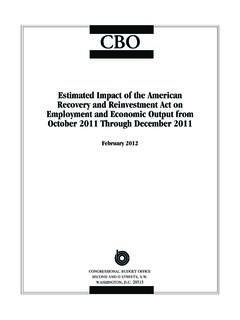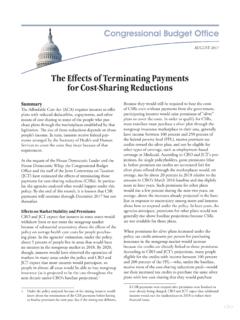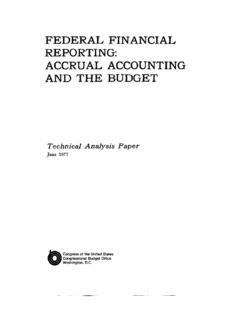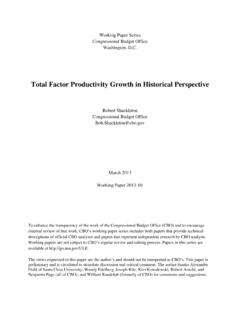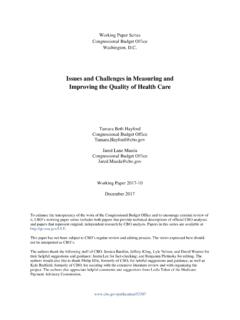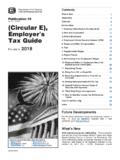Transcription of Monthly Budget Review: February 2022
1 The amounts shown in this report include the surplus or deficit in the Social Security trust funds and the net cash flow of the Postal Service, which are off- Budget . Numbers may not sum to totals because of rounding. The federal Budget deficit was $475 billion in the first five months of fiscal year 2022, the Congressional Budget Office estimates. That amount is less than deficits recorded during the same period in the two prior fiscal years: It is less than half the shortfall recorded for the same months in fiscal year 2021 ($1,047 billion) and three-quarters of the deficit recorded in 2020 ($624 billion), just before the start of the coronavirus pandemic.
2 From October 2021 through February 2022, revenues were $371 billion (or 26 percent) higher and outlays were $201 billion (or 8 percent) lower than they were during the same period a year ago, CBO estimates. Table 1. Budget Totals, October February Billions of Dollars Actual, FY 2021 Preliminary, FY 2022 Estimated Change Receipts 1,436 1,807 371 Outlays 2,483 2,282 201 Deficit ( ) 1,047 475 571 Data sources: Congressional Budget Office; Department of the Treasury. Based on the Monthly Treasury Statement for January 2022 and the Daily Treasury Statements for February 2022.
3 FY = fiscal year. Total Receipts: Up by 26 Percent in Fiscal Year 2022 Receipts totaled $1,807 billion during the first five months of fiscal year 2022, CBO estimates $371 billion more than during the same period a year ago. Monthly Budget Review: February 2022 March 8, 2022 Monthly Budget REVIEW FOR February 2022 MARCH 8, 2022 2 Table 2. Receipts, October February Billions of Dollars Estimated Change Major Program or Category Actual, FY 2021 Preliminary, FY 2022 Billions of Dollars Percent Individual Income Taxes 704 975 271 38 Payroll Taxes 535 577 43 8 Corporate Income Taxes 89 117 28 31 Other Receipts 108 138 30 27 Total 1,436 1,807 371 26 Memorandum.
4 Combined Individual Income and Payroll Taxes Withheld taxes 1,064 1,334 271 25 Other, net of refunds 175 218 43 24 Total 1,239 1,552 313 25 Data sources: Congressional Budget Office; Department of the Treasury. FY = fiscal year. Individual income and payroll (social insurance) taxes together rose by $313 billion (or 25 percent). Most of that increase occurred because amounts withheld from workers paychecks rose by $271 billion (or 25 percent). That result was attributable in part to higher total wages and salaries, particularly among relatively high-income workers who are subject to higher tax rates on earnings.
5 In addition, legislation enacted in response to the pandemic caused timing shifts in the collection of payroll taxes. Most significantly, employers could choose to defer payment of their portion of certain payroll taxes on wages paid from March 27, 2020 (the date of enactment of the Coronavirus Aid, Relief, and Economic Security Act), through December 31, 2020. That provision required half of the payroll taxes deferred in calendar year 2020 to be paid by December 31, 2021. Nonwithheld payments of income and payroll taxes rose by $41 billion (or 20 percent).
6 The first quarterly payment of estimated individual income taxes in the current fiscal year was due by January 15. Partially offsetting those increases, individual income tax refunds increased by $6 billion (or 14 percent). The precise timing of refund payments varies from year to year, but most will be paid in the period from February through April. The Internal Revenue Service reports that the total number of refunds issued through the third week of February was 33 percent more than in the same period in 2021 but 41 percent below the number for the same week in 2020 a probable result of continued delays in processing tax returns.
7 Average refunds in 2022 are larger, however, because of the recovery rebates (also known as economic impact payments) and the expanded child tax credit that were part of the pandemic response. Monthly Budget REVIEW FOR February 2022 MARCH 8, 2022 3 unemployment insurance receipts (one type of payroll tax) were $8 billion (or 50 percent) higher than in the same period a year ago because states were replenishing the balances in their unemployment insurance trust funds, at least in part by collecting more in unemployment taxes from employers.
8 (The trust funds had been depleted by unusually high unemployment beginning in March 2020.) Those collections count as federal revenues, reflecting the nature of the unemployment insurance system, which is a federal program administered by the states. Collections of corporate income taxes increased, on net, by $28 billion (or 31 percent). For most corporations, the first quarterly estimated payment for fiscal year 2022 was due on December 15. Receipts from other sources, on net, increased by $30 billion (or 27 percent).
9 Remittances from the Federal Reserve increased by $15 billion (or 44 percent). Additional interest earnings on assets purchased since last year contributed to the rise. Customs duties rose by $10 billion (or 32 percent), reflecting an increase in imports. Excise taxes rose by $7 billion (or 29 percent), reflecting a general increase in economic activity. Total Outlays: Down by 8 Percent in Fiscal Year 2022 Outlays in the first five months of fiscal year 2022 were $2,282 billion $201 billion less than during the same period last year, CBO estimates, the net result of several increases and decreases.
10 The largest changes, all decreases, were as follows: Outlays for unemployment compensation decreased by $139 billion, from $160 billion in the first five months of fiscal year 2021 to $20 billion in the first five months of 2022. That spending declined both because the enhanced benefits that were enacted earlier in the pandemic expired in September 2021 and because unemployment declined. In comparison, during the first five months of fiscal year 2020, just before the start of the pandemic, outlays for unemployment compensation totaled $14 billion.
